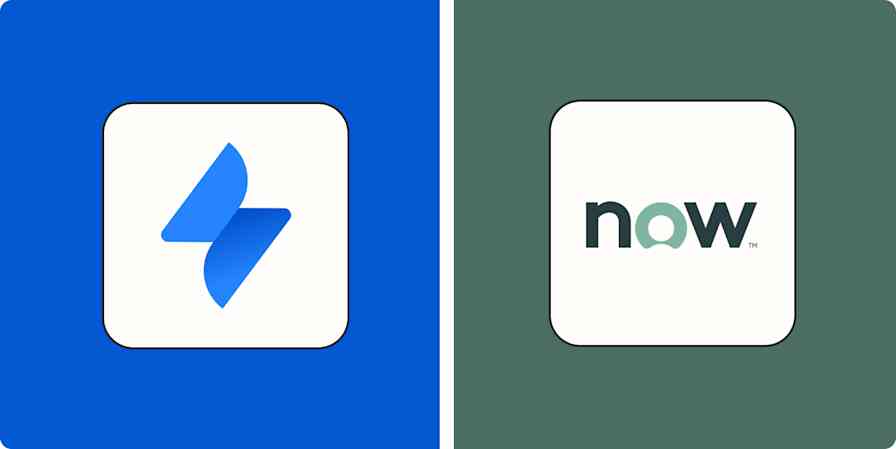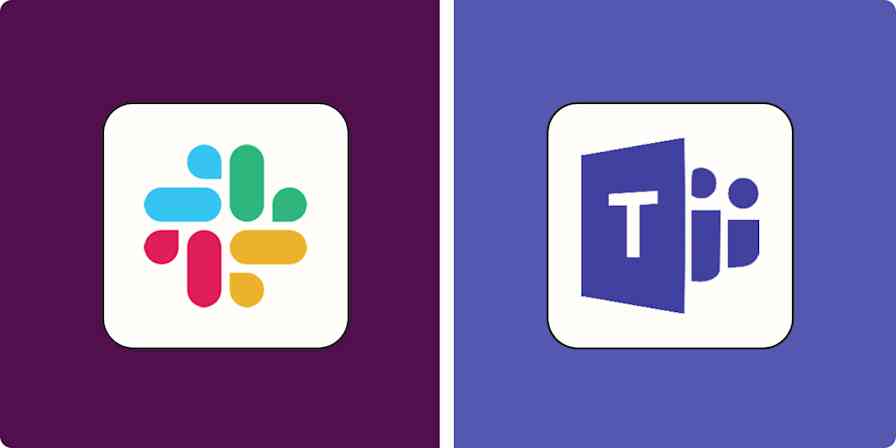If you run projects that touch multiple team members' hands, manage a remote team or hybrid office, or (like me) compulsively make lists and love to stay organized, you probably need project management software.
Whether your colleagues are working across the office or across the globe, PM software like Asana and Jira can help you do all the above. Each tends to position itself with slightly different customer bases, but either could make a huge difference in getting everybody on your team on the same page.
Picking between Asana vs. Jira could be as easy as understanding your needs, but after testing each of them thoroughly over the past couple years, here's how I see them from a user perspective.
Asana vs. Jira at a glance
Here's how Asana and Jira differ at a high level:
Jira tends to position itself toward DevOps teams, while Asana is a less industry-specific product.
Asana has top-notch design, UX, and general utility, but Jira has more advanced features and integrations.
Asana's reporting and project boards are sharper, more robust, and include automation features.
To keep things clear for this comparison, it's worth noting that Jira is just one tool in Atlassian's product suite, and it breaks down into two products: Jira Software—the project and issue tracking software I'll be discussing below—and Jira Service Management, which is an IT service management (ITSM) tool.
| Asana | Jira |
|---|---|---|
UX | ⭐⭐⭐⭐⭐ Asana's software is easier to use, more attractively designed, and more intuitively structured. | ⭐⭐⭐⭐ Jira is generally very easy to use but lacks some of Asana's design and organizational attention. |
Dashboards | ⭐⭐⭐⭐ Asana offers a general dashboard and a reporting dashboard but isn't as customizable as Jira. | ⭐⭐⭐⭐⭐ Jira allows you to create multiple dashboards and has a wide range of gadgets to add to them. |
Project management | ⭐⭐⭐⭐ General use PM is easier and better organized with Asana, but users looking for issue tracking may prefer Jira. | ⭐⭐⭐ For pure PM, I thought Jira was a little lacking, but it's better designed for issue tracking and DevOps use. |
Reporting | ⭐⭐⭐⭐⭐ Reports are well designed, wide-ranging, and allow custom building. | ⭐⭐⭐ Jira offers fewer report templates and only allows custom reporting to administrators on company-managed accounts. |
Integrations | ⭐⭐⭐ The Asana app marketplace is about a third the size of Jira's, but users may find they get more of what they need from the native utility. It also integrates with Zapier. | ⭐⭐⭐⭐⭐ Managed by Atlassian, Jira has a bustling app marketplace and comes in multiple product categories. It also integrates with Zapier. |
AI | ⭐⭐⭐⭐⭐ Asana Intelligence offers a ton of useful AI tools with both paid tiers. | ⭐⭐ Currently no AI features, but there's a waitlist for Atlassian Intelligence; connects through Zapier to common AI tools; Atlassian Marketplace has some AI apps. |
Pricing | ⭐⭐⭐ Asana's free offering is pretty generous, it has no Enterprise option, and its paid packages are nearly twice the price of Jira's: Personal (free), Starter ($13.49/user/month) and Advanced ($30.49/user/month). | ⭐⭐⭐⭐⭐ Jira is notably cheaper than Asana, has a strong free offering, and includes an Enterprise option: Free, Standard ($8.15/user/month), Premium ($16/user/month), and Enterprise. |
Asana offers better user experience and more utility as a pure task manager than Jira
Right off the bat, both products look almost identical. In fact, both project boards look more or less the same.
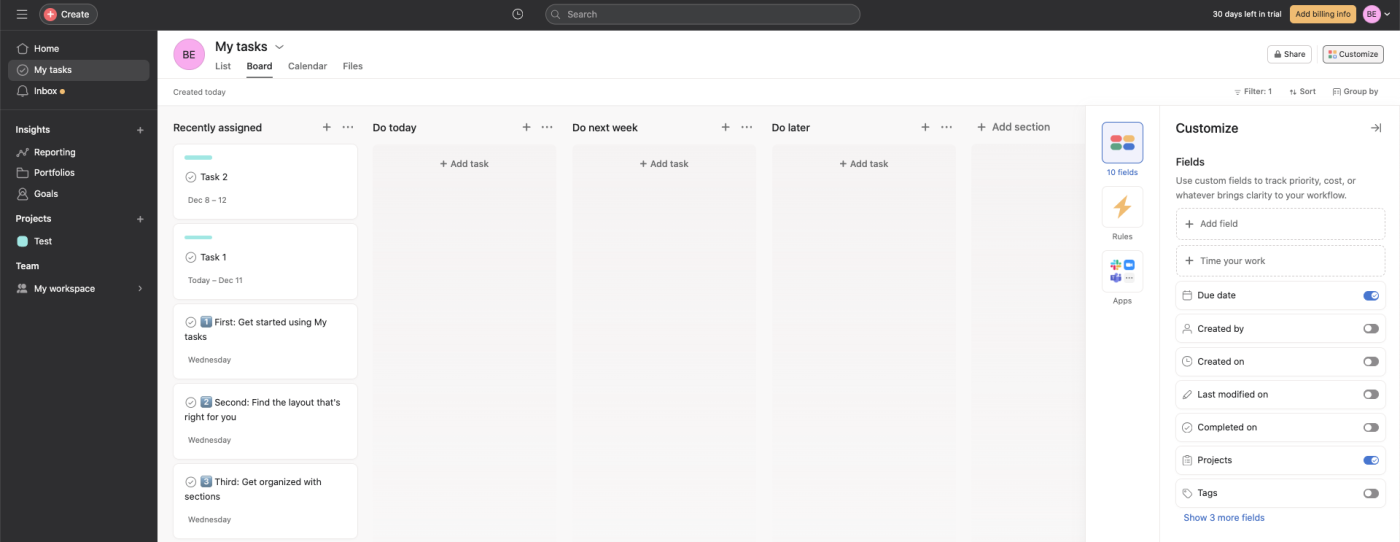
As far as presentation goes, what I like slightly more about Asana is how it strips down your sidebar options to a bare minimum while giving you tabs at the top to toggle the view between Kanban board, Gantt chart, and Calendar. Within the boards, it's extremely easy to add custom fields or adjust the details included on each task. You can even incorporate apps and set up automatic rules straight from the board.
Overall, Asana just feels very polished, crisp, and attractively designed. It's a visually striking, responsive, and smartly constructed platform with very good UX. Even its themes and colors look premium.
When it comes to task managing, Jira is almost equally functional. You can easily set up projects as Scrum or Kanban, but in my opinion, the layout is a little more simplistic and doesn't have quite the same level of design as Asana. The functionality is almost identical—drag and drop tasks, update phases, assign team members, etc.—but from a UX standpoint, I found I preferred Asana.
I thought Jira's navigational design was less intuitive. It packs the view options into the sidebar or top nav along with completely separate features like Reports and Issues, giving work-related actions and views equal weight. It also uses a simple dropdown to customize the board, which isn't a big deal, but Asana gets points here for including the app and rule options in a pop-out menu so you can easily integrate them into workflows.

Structurally, I think Asana's setup makes a little more sense: you start on a helpful dashboard, then navigate to your task board by going to My Tasks on the sidebar. In Jira, you start on a pretty nondescript projects page and have to navigate to a project or go two more clicks through the Dashboards dropdown just to get somewhere useful.
Are any of these deal-breaking issues? Not really. But Asana wins for having an overall simpler experience, more thoughtful product design, and sharper visuals.
Jira is pretty clearly geared toward DevOps, while Asana has more general project management appeal
As you peruse Jira, it becomes pretty clear that it's slanted toward DevOps teams. If that's what you're looking for, Jira is probably your best bet. But that doesn't mean it can't be effective for general project management use.
Tasks are categorized in Jira as Issues, which is an obvious clue that Jira tends to be a go-to choice for issue tracking. The task tracking follows a similar theme, even allowing you to search tasks by JQL text. Many of its reports and gadgets revolve around metrics like age, time spent in a given status, resolution percentage, sprints, workloads, and issue analysis.
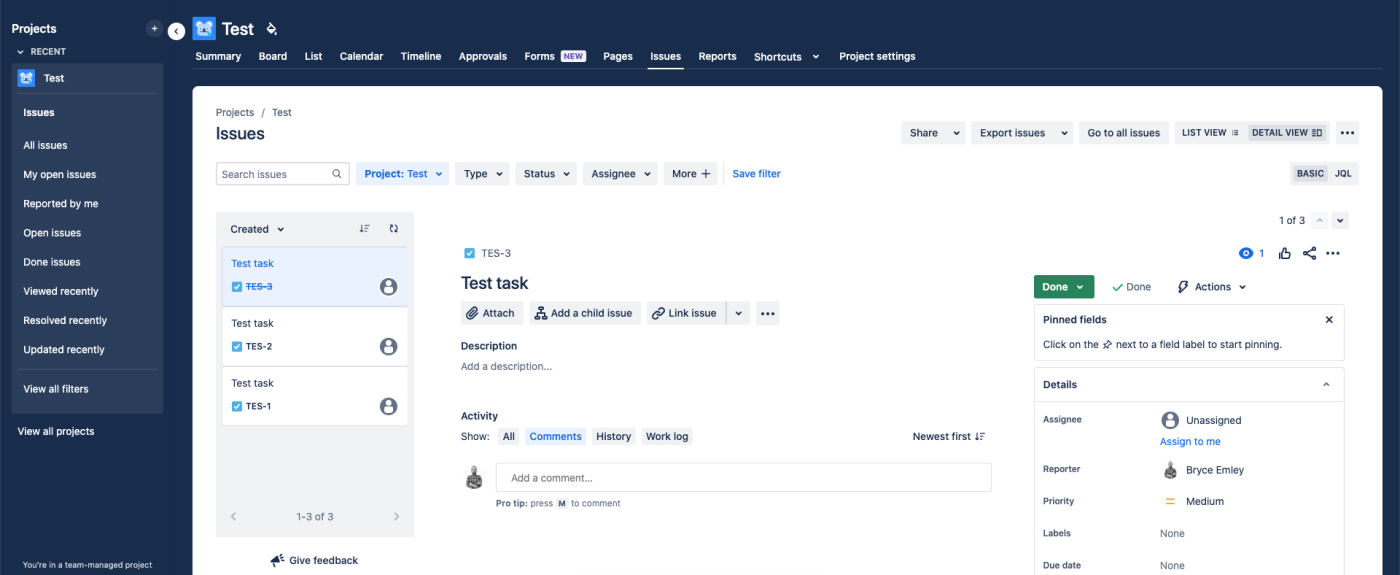
I could see how users might feel a bit siloed in Jira as well. You can leave comments on tasks, hit team members with an @ notification, vote, and share straight to Slack, but for the most part, it's not built for high-level collaboration. If you really want to achieve that, you'll have to integrate a solution like Confluence, Atlassian's workspace collaboration tool for chat, calendar syncing, and project documentation. Confluence is free, so, again, not a deal-breaker.
Asana feels better built for collaboration out of the box. Its built-in chat feature is pretty slick, and connected profiles just feel more present. By hovering over a team member with your cursor, you can instantly start a chat, create a 1:1 project, or dive into its profile to see your interaction and collaboration history.
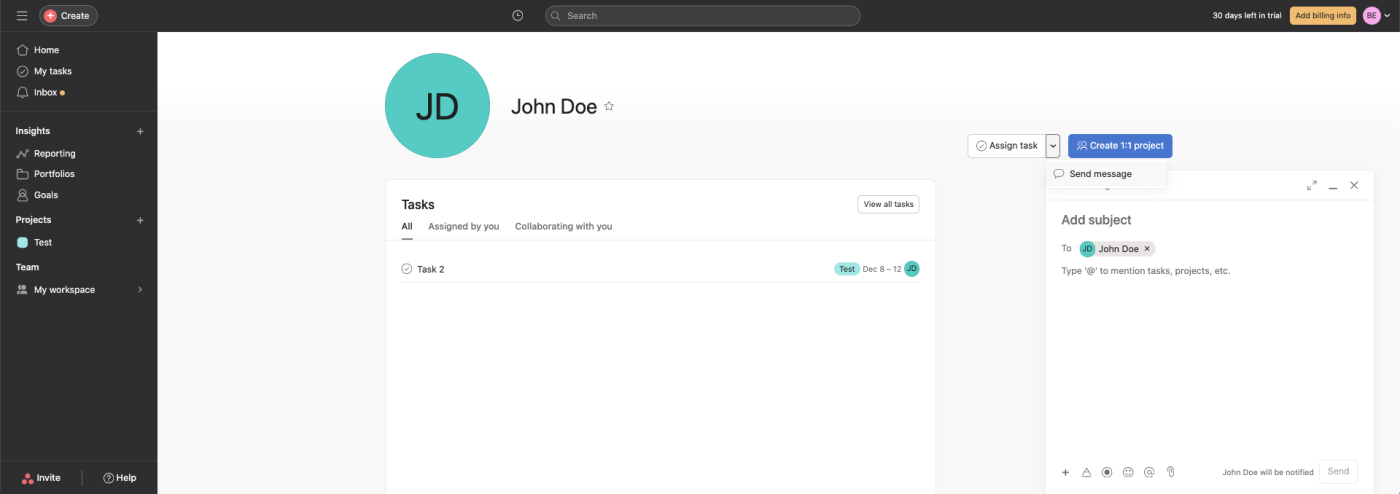
I also like how Asana lets you wrap projects into individual portfolios and adds yet another layer of organization. All your tasks, projects, and portfolios can even feed into generalized goals to help keep team members on track for things like quarterly progress tracking.
If you wanted to use Asana for issue-tracking, you could make it work for that purpose, but Jira is just more directly designed to handle that sort of reporting and workflow managing. It's not a stretch to say that while Jira is clearly positioned for DevOps teams, it's also still very usable for general project management. But if you're looking for basic PM utility for tracking tasks and joining team members, Asana may be a better pick.
Asana's dashboard is more user-friendly, but Jira's is more robust
Unlike their boards, Asana's and Jira's dashboards are noticeably different.
True to form, Asana's dashboard is more dynamically designed than Jira's. In Asana, the dashboard is considered the home screen. As of this writing, there are only a handful of widgets you can add—all of which are moderately useful. Unless you prefer to dive right into your tasks, I find that it's helpful to have an all-in-one hub that shows you things like goal progress, personal notes, and priority tasks across projects.

Jira's dashboard feature is definitely a bit lacking in presentation compared to Asana's, but its functionality makes up for it. The design is pretty bare bones, but it's super easy to customize and includes a really wide range of "Gadgets" (AKA widgets). You can add tons of useful reporting information and visualizations to your dashboard, including things like assigned issues, average time in status, bubble charts, issues created vs. issues resolved, heat maps, and much more. You can even have your dashboard displayed as a slideshow for presentations. Plus, you can save and share multiple dashboards to suit your team needs.
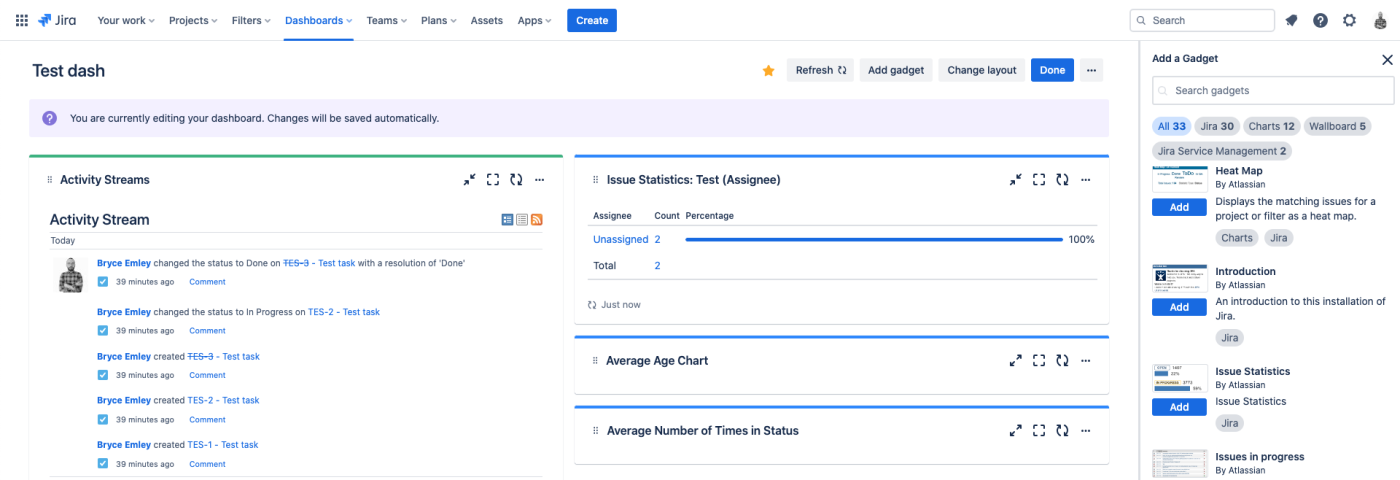
I give Jira an easy win for dashboards based on its range of reporting features and ability to create more than one.
Asana has superior reporting capabilities
When it comes to reporting, I'd consider Jira capable but not exceptional. Its designs are pretty simplistic, and the available report types are somewhat limited.

Jira breaks its 11 total report types into three categories: issue analysis, forecast and management, and "other," which currently only houses a workload pie chart. Issue analysis has the most options and includes essentials like average age, resolution time, and created vs. resolved. Curiously, only company-managed (rather than team-managed) projects have access to custom report creation. It's worth noting that Atlassian's app marketplace offers hundreds of reporting integrations, so there's a good chance you can add apps to help improve Jira's native reporting situation.
Like the rest of its dashboard, Asana's reports are clean, responsive, and crisply designed. You can choose from more pre-built reports on everything from project progress to work health to resourcing and can easily create custom reports. These reports are housed in a separate dashboard, which I also think is smart. Where Jira's general dashboard holds your favorite reports alongside personal task management gadgets, Asana separates its general task dashboard from the reporting one so you can go to one spot to find only your key tracking and monitoring visuals.
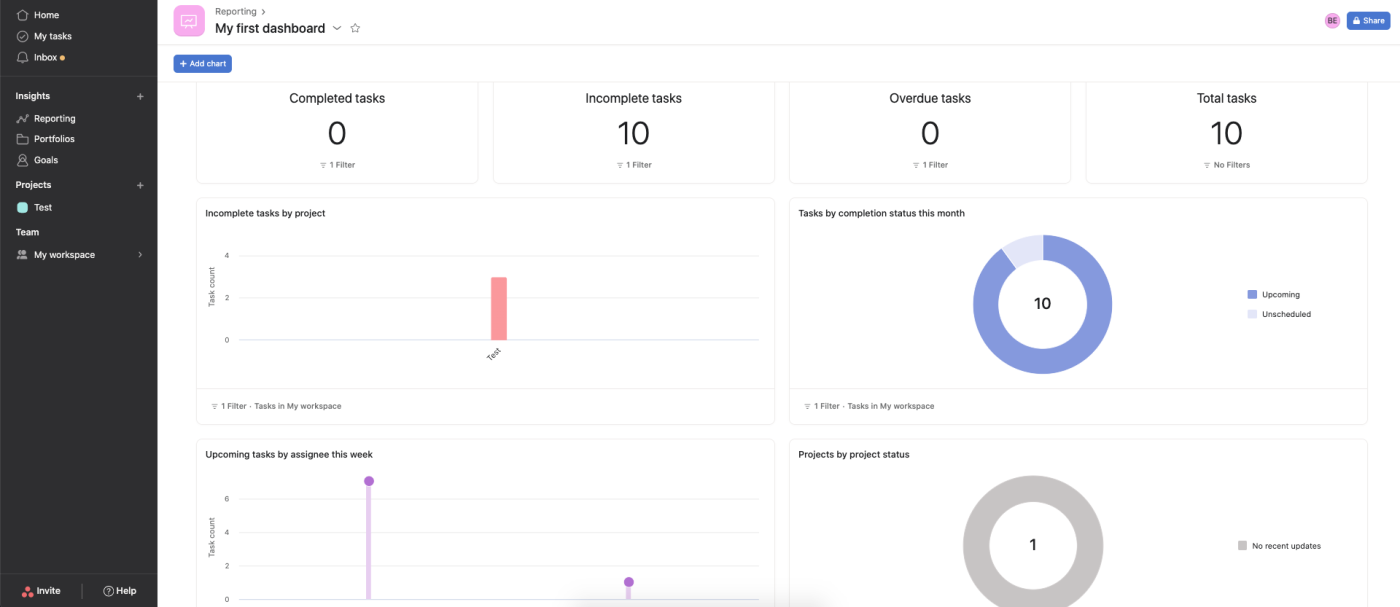
Based on native utility, versatility, and customizability, Asana gets another easy win for reporting.
Jira has more integrations and product offerings than Asana
One place Jira really shines is its integrability. There are over 1,000 apps available for integration with Jira Cloud in its app marketplace, so chances are you can make Jira work with just about any popular apps you use. There are nearly 800 project management apps and around 350 IT/help desk apps, plus another 400+ reporting integrations, so you can likely supplement a lot of the lacking functionality in Jira's native offerings with third-party solutions.
Jira also has a pretty wide range of broad product offerings. For the purposes of this comparison, I'm specifically looking at Jira Software for project and issue tracking with Confluence for added document collaboration, but you could also go with the Service Management option for ITSM.
Asana's app store is definitely smaller, coming in at just under 400 total apps by my count, though it continues to add more by the month. You'll find the usual suspects like Slack, Teams, and Adobe Creative Cloud. Surprisingly, one of its biggest app categories is IT and dev—if you want to use Asana for IT, it has around 70 apps to support you.
Both tools connect to Zapier, which opens them up to thousands more integrations. For example, you can automate Jira to create issues from Google Sheets rows or send messages on Discord when new issues are created. Or you can automate Asana to create new Google Calendar events from Asana tasks or create Asana tasks from new Airtable records.
Here are a few pre-made automations to get you started, but you can connect Jira and Asana with almost any app in your tech stack.
Create Jira Software Cloud issues from new Google Sheets rows
Zapier is the leader in workflow automation—integrating with 6,000+ apps from partners like Google, Salesforce, and Microsoft. Use interfaces, data tables, and logic to build secure, automated systems for your business-critical workflows across your organization's technology stack. Learn more.
Both apps promise AI features, but Asana already has them
AI functionality is becoming an imperative for just about every software class, and project management products are no exception. And as of this writing, Asana is the only one of the two that has it. (Transparency note: I couldn't test Asana Intelligence, as it currently has no trial feature, so this is just a feature summary.)
Asana Intelligence, Asana's native AI tool, is available with both paid tiers and offers a ton of useful productivity features, including smart goals that leverage historical activity to come up with potential achievements, a smart assistant that can help you navigate projects when you ask questions, smart workflow suggestions, and generative AI that can draft messages and summarize conversations. Still in its early days, Asana promises even more features are coming.
Jira doesn't yet have AI, but there's currently a waitlist for its parent company's AI offering, Atlassian Intelligence, so it may be live by the time you read this. It's described pretty identically to Asana Intelligence, so once it's rolled out, I'd expect it to be basically the same. In the meantime, Atlassian Marketplace has a handful of AI apps you can connect for specific tasks, like issue description generation, and Jira Service Management offers an AI-powered service agent you can deploy. Plus, you can use Zapier to connect Jira to popular AI apps like ChatGPT.
Asana vs. Jira: Which is best for you?
At the beginning of this post, I said picking between Asana vs. Jira may be as simple as knowing your team's needs. By the end of this analysis, I think it really may be that simple.
Jira comes out as the better pick if you want a product that helps organize ticketing, dev, and issue management. For more general workflows, I think Asana offers a better overall experience.
Asana vs. Jira FAQ
Which is better: Jira or Asana?
In general, Jira tends to be a better choice for DevOps teams, ticketing, and integrating third-party applications. Asana has a more user-friendly interface for general project management.
What is the difference between Asana and Jira?
The main difference between Asana and Jira is that Jira is positioned more for issue tracking and supporting IT workflows. It can definitely be used for project management across industries, and Asana could also be effective for DevOps, but those aren't necessarily its primary uses.
What is Asana?
Asana is project management software that you can use for organizing teams, tasks, and workflows. You can also use it for reporting and integrating workflow automation.
Is Asana free?
Asana has a basic free plan that includes unlimited essentials, up to three project views, and basic workflows and reporting. While the Starter and Advanced plans aren't free, they do have free 30-day trial offerings.
Related reading:
This article was originally published in January 2023. The most recent update was in January 2024.


